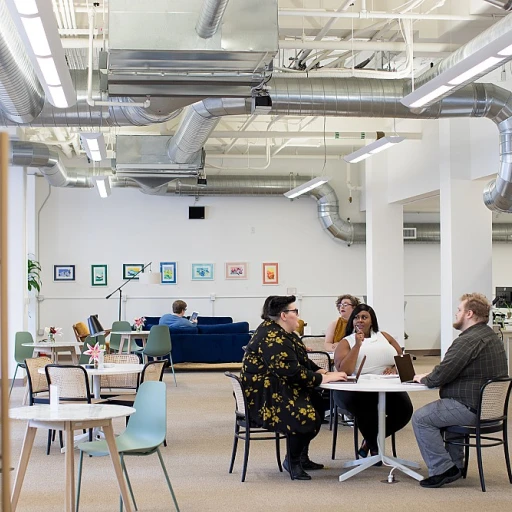Understanding the Concept of Bluebird Jobs
Defining the Bluebird Job Landscape
Understanding the concept of bluebird jobs is crucial for those looking to navigate the sea of opportunities within the tech industry. Bluebird jobs, often characterized by their unique and evolving nature, represent positions that require specific expertise and adaptable skill sets. These roles are not just about filling a seat but are more about blending with the team and contributing to a dynamic work environment. Often associated with high-level expertise and innovation, bluebird jobs are increasingly being recognized as the blue-chip positions within tech enterprises. In today's competitive market, bluebird roles are the cornerstone of companies' success, demanding the best talent to help drive forward their objectives efficiently and effectively. Industries such as health care, particularly hospitals health and mental health services, view these positions as pivotal for providing state-of-the-art care services. While many open jobs do not explicitly fall under the 'bluebird' category, discerning candidates and employers recognize the potential for career growth through these roles. Positions often open within arenas like design engineering, supply chain management, and tech support, all requiring innovation and a best-in-class approach. The allure of bluebird jobs is not just in the responsibilities they entail but in the opportunity to join a team dedicated to early adoption of technology and comprehensive solutions. Companies located in tech hubs like Fort Valley emphasize not only the job but the chance to participate in designing the future of work. For those contemplating a transition into these coveted roles, now is the time to act. The market's current demands highlight the necessity for full-time employees ready to embrace new challenges and leverage early shifts, often working flexible hours to align with global markets. By joining such a team, individuals can significantly impact helping people through cutting-edge projects, setting themselves on a path of long-term success with profound professional benefits. For those interested in further exploring this career path, the additional opportunities with Sewell careers in the tech industry provide another avenue to consider, underscoring the variety and scope of bluebird jobs available today.The Unique Challenges in Hiring for Bluebird Jobs
Overcoming Hurdles in Securing the Right Fit
Navigating the hiring landscape for bluebird jobs presents distinct challenges that require specific strategies to ensure organizations can thrive. The commitment to care and dedication demanded in this sector push the boundaries of traditional hiring approaches.- Diverse Skill Requirements: Bluebird jobs often require a combination of highly specialized skills and a passion for helping people. This includes roles like design engineer or mental health expert within healthcare services. Balancing technical expertise with empathy becomes vital in selecting potential team members.
- Time Constraints: The demand for filling these positions swiftly is coupled with the need for meticulousness. With open jobs requiring full-time commitment in bustling areas like Fort Valley, the pressure is high to secure candidates quickly. Consequently, hiring teams must streamline their processes without compromising on quality to meet the health care needs.
- Cultural Fit: Building the best care team involves more than assessing capabilities on paper. It necessitates discerning applicants' alignment with the organization's values and goals, ensuring they are prepared to join team settings that demand collaboration and shared dedication to mental health and care services.
- Attrition and Retention: In the early days of employment, ensuring that new hires integrate well into their roles within hospitals health settings is crucial. Offering career growth opportunities and a supportive work environment helps reduce turnover and fosters long-term commitment.
- Balancing Privacy and Transparency: Maintaining a balance between transparency in job roles and preserving applicants' privacy is critical. Adhering to privacy policy and cookie policy requirements while effectively communicating job expectations and organizational culture remains a predominant focus.
Strategies for Attracting Top Talent
Crafting a Magnetic Presence
In today's competitive landscape, attracting the best talent for bluebird jobs, especially in tech-oriented fields, demands an innovative approach. The key is to create an environment and brand that speaks to the aspirations of potential hires. Firstly, it's vital to understand what distinguishes these opportunities from others. Bluebird jobs often require a blend of technical expertise and a passion for helping people, especially within the health care and mental health sectors. This is where showcasing the unique nature of these roles can play a pivotal role. Potential candidates are more inclined to join a team that expresses a clear-cut vision tied with purpose and impact. Moreover, early engagement with prospective candidates can be crucial. Integrating active recruiting techniques and job previews can spark interest among potential candidates. Effective ways include participation in industry events, collaborating with educational institutions, or tapping into niche online communities where conversations about tech and health care services are underway.Innovative Approaches in Work Culture
One effective strategy is to prioritize a work culture that values diversity and innovation. Highlighting a company's commitment to career growth, inclusive work environments, and flexibility—such as remote or full-time hours—can significantly increase its drawing power. Given that candidates often seek a balance between personal time and career commitments, emphasizing these flexible arrangements can be critical. Additionally, it is beneficial to incorporate employee testimonials and case studies on how others have navigated their career paths within the company. This not only humanizes the organizational brand but also provides insight into what potential newcomers can expect.Utilizing Technology to Enhance Reach
In the digital age, leveraging technology is indispensable. Utilizing platforms that allow targeted job advertisements and harnessing data analytics can aid in identifying candidates who align with the company's ethos and requirements. Moreover, implementing tech-driven recruitment tools can streamline the process, making it efficient for hiring managers and offering a more engaging experience for the applicants. Organizations investing in state-of-the-art recruitment technologies typically find that their supply chain—from outreach to onboarding—runs seamlessly. For more insights on overcoming modern recruitment hurdles, check out this navigating remote work challenges blog post. These strategies not only involve attracting but also retaining top talent by ensuring they feel valued and supported from the hiring phase throughout their tenure.Leveraging Technology in the Hiring Process
Innovative Approaches to Enhance the Hiring Journey
To stand out in the competitive landscape for bluebird jobs, integrating innovative technology into the hiring process is not only beneficial but crucial. With the digitalization of recruitment, organizations have at their disposal several tools and systems which streamline efforts to connect with the right candidates more efficiently. One of the most effective means of optimizing the hiring process is utilizing advanced applicant tracking systems (ATS). These systems offer a centralized platform where hiring managers can track and evaluate a candidate's journey from application to onboarding. By automating repetitive tasks such as resume screening and interview scheduling, ATS allows the recruitment team to focus on assessing candidates' skills and compatibility with their team culture. Incorporating AI-driven tools in the hiring process aids in identifying candidates whose skills align with the technical demands of specific bluebird positions. Whether looking for a talented design engineer in the valley or a supply chain expert to manage the fort's demands, AI tools can swiftly match candidate profiles to open jobs based on qualifications and experience. Moreover, bluebird companies can leverage the power of data analytics to predict hiring trends, helping teams prepare for peak recruitment days. This ensures that the best care is given in terms of attention and resources, maximizing the potential for successful candidate integration into the care services sector. Beyond technology, fostering a transparent communication channel is essential. Establishing a clear privacy policy, cookie policy, and open communication about mental health considerations can create an inviting environment that encourages top talent to join the team. Hiring processes that emphasize career growth and full-time opportunities in health care and hospitals can further draw in candidates dedicated to helping people. Time employees, weighed down by the burden of lengthy and convoluted hiring processes, are more likely to be captivated by companies that prioritize efficiency and candidate care. Balancing these tech-driven approaches with genuine human interaction ensures the recruitment process is optimized for both the organization and potential team members. By staying abreast of technological advancements and integrating them into recruitment strategies, bluebird companies can create a hiring process that not only attracts but retains the best talent, positioning them as leaders in their field.The Role of Continuous Learning and Development
Fostering Continual Learning and Growth in Bluebird Roles
Developing a culture of continuous learning and development is crucial when hiring for bluebird roles. The fast-paced nature of tech industries, combined with the unique pressures faced by bluebird jobs, necessitates a commitment to ongoing education and skill enhancement. To nurture this environment, companies should consider implementing the following strategies:- Customized Training Programs: Design training modules that cater specifically to the challenges and responsibilities of bluebird roles. This could include workshops on the latest technology trends, problem-solving approaches, and mental health support mechanisms.
- Strong Mentorship System: Establish a mentorship program where experienced team members assist new hires in navigating the complexities of their roles. This not only facilitates knowledge transfer but also fosters a supportive work culture.
- Regular Feedback and Open Communication: Creating channels for feedback allows team members to express concerns and contribute ideas, enhancing job satisfaction and productivity.
- Encouraging Skill Diversification: Offering opportunities for team members to explore different areas within the organization encourages adaptability and prepares them for potential future transitions.
- Investing in Mental Health and Well-being Initiatives: Providing access to mental health care services and promoting work-life balance can help reduce burnout and boost overall productivity.
Future Trends in Bluebird Job Hiring
Trends Shaping the Future of Bluebird Job Hiring
As the landscape of bluebird jobs continues to evolve, several trends are poised to influence how hiring practices will adapt in the future. With a focus on helping people find the best career growth opportunities, both employers and prospective employees can benefit by staying ahead of these trends.
One significant trend is the increased emphasis on health care services. As demand rises in hospitals health and other care sectors, hiring processes are reshaping to prioritize skills in these areas, ensuring prospective team members can effectively join the care teams. The integration of mental health considerations into the hiring process is also gaining traction, influencing both candidate selection and retention strategies.
Technology will continue to play a pivotal role. Just as current hiring strategies leverage advanced tech to streamline processes, future innovations are likely to target how teams manage privacy policies and time employees effectively. Enhancing design engineer roles and optimizing supply chain functionalities will be crucial as well.
The hybrid work model, incorporating both remote and on-site work days, remains a mainstay, with open jobs offering flexible hours to attract diverse talent pools. This flexibility caters to the needs of both early career professionals and those seeking full-time positions, underscoring the importance of adaptable work arrangements in attracting top talent.
Additionally, the concept of team culture is becoming more prominent. New hires joining bluebird teams are not just filling positions but are actively participating in shaping the workplace environment. This focus on culture aligns with broader trends in ensuring that job offers cater to the values of fort valley firms, promoting an inclusive atmosphere where innovation can thrive.
To stay competitive, organizations must continue to adapt their hiring strategies. Emphasizing the significance of continuous learning and career development will attract top-notch professionals eager to join teams that care deeply about their growth and satisfaction in their blue bird roles.








